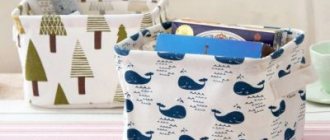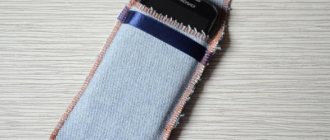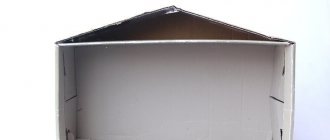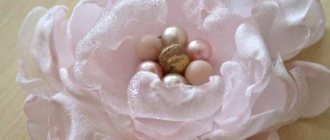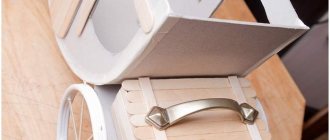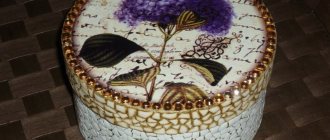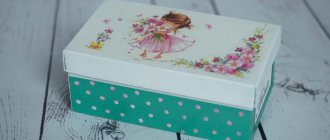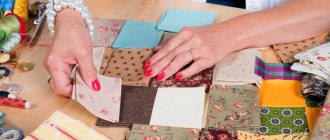Who is not familiar with the picture - the shelves in a linen closet or chest of drawers are littered with chaotically lying linen, among which it is not so easy to find the right set or pair of socks. And the order put in place during general cleaning, all these neatly folded piles turn into a heap again after a few days.
In order to easily navigate your shelves and not waste time searching, humanity came up with organizers that help maintain order. Of course, you can buy them - fortunately, the choice of sizes, colors, and functional purposes is great. But it’s much more pleasant to make it yourself, because this way you can create a unique thing that will meet exactly your needs.
Fabric organizer options
There are different types of storage organizers. They differ in the area of their use, the form of fasteners, and for what purpose they are used.
Depending on whether the module will move in space or not, they are divided:
- Mobile boxes that are moved to different points (box for jewelry).
- Stationary options that are constantly in one place. They are fixed in a certain area (cabinet door, wall, car seat).
The following types are determined by the type of fastener:
- Floor or tabletop.
- Built into a specific location. For example, organizers located on a furniture shelf or in a desk drawer.
- Mounted options that are fixed to the surface of the selected area.
If we consider models created to contain a certain group of objects, we distinguish:
- Boxes for underwear are a fabric structure with a solid base. There may be varieties made of transparent material, plywood or cardboard. The sections are located mainly vertically, and the partitions are often made of felt and corrugated cardboard. For bras, they create practical models with compartments located along them.
- Tools are made in the form of holders (when special brackets are fixed to the wall) and a wall-mounted plywood module. Field technicians prefer to take with them stationary or removable boxes with compartments. To store a small set of tools, use a backpack in the form of a fabric organizer or duffel bag.
- Stationery is laid out in combined or simple boxes made of wood, plastic or metal.
- For shoes , a device made like a stationary furniture structure is suitable. There are horizontal and vertical variations. The first type can accommodate up to 20 pairs of shoes, and the second - about 4. The module, which provides for a vertical position, is mounted on a wall, floor, door, closet or any niche of appropriate size.
- For cosmetics, documents or small items, portable boxes are used.
List of original ideas for an organizer:
- key holder (key hanger);
- bag-mat for containing toys;
- various containers for small items;
- multi-tiered plate for cosmetics;
- pockets hanging from the wall;
- hanging toilet paper holder;
- hanger with rings for scarves and scarves;
- wall module for cups;
- a lattice in the hallway for placing keys, glasses and flower pots.
Storing small items
Surely you have often noticed that there are various small objects that do not have their place. This could be anything from threads and ribbons to pencils and pens in the kitchen. It is for such things that you need an organizer in the kitchen.
First, let's start transforming the jars, or rather, cleaning them.
We make a paper stencil of the same shape as the jars will be and transfer it.
Carefully cut out jars of the same size.
To keep the edges from being sharp, be sure to sand them down.
Prepare a board with holes at the same level.
We screw the fasteners so that the organizer is securely held on the wall, as well as the handles.
When everything is ready, you can safely hang the jars and fill them with various little things.
Textile organizers with pockets
Organizers for storing things with pockets are not difficult to make. To make the basic version you will need simple materials.
This:
- a large piece of fabric for a 2-sided base of the craft;
- smaller fabric for pockets;
- durable thin plastic for fastening parts (replaced with dublerin, which is glued with an iron);
- bias tape or tape for processing the product;
- eyelets.
Execution order:
- Sewing is done by hand or on a sewing machine.
- First, it is recommended to decide on the size of the fabric model and the size of the pockets. Sheet A4 is used as a standard template.
- Cut out rectangular shapes of the appropriate scale from plastic material, and from fabric - blanks 2 times larger. You should leave 2-3 cm for the volume of the parts and take into account seam allowances.
- Fold each pocket segment in half with the right side out, place a piece of plastic inside and stitch along the top.
- Iron the material on the sides outward in the form of an “accordion” so that there are allowances on the side.
- Next you need to stitch the edge folds of the pocket. Treat each pocket in the same way.
- To make the base of the organizer, you need to place a plastic piece between the layers of a double fabric blank.
- Place small parts on the created base and secure them with pins.
- Sew the pockets to the main module.
- Then take a round object and use it as a template to round the corners of the base.
- Treat the craft with tape or ribbon in a circle.
- Mark the installation location for the eyelets and attach them.
Option for making an organizer for the hallway:
- The first stage involves cutting out 2 rectangles from dense material, measuring 80x40 cm (any size can be chosen as desired).
- Sew the created segments first with the wrong side up, then turn them right side out and stitch along the edges.
- Cut 4 strips from this or another suitable fabric.
- From the stripes, make 4 pocket lines, each with 2 pockets.
- Next, fold the upper edges of the fabric runner and trim it with colorful braid or decorate it with applique.
- Each pocket should be given depth using 2 folds that are not secured at the top.
- Sew the strip with creases on 3 sides and between the pockets.
- Seal the bottom edge of the sewn bags with finishing material or braid. It will cover the edge and secure the folds.
Hanging organizer
Method for making an organizer for needlewomen:
- Steam the fabric piece with an iron and cut out 2 rectangular shapes from it, the width of which is 5 cm + (2 cm for allowances) larger than the hanger, and the length can be adjusted as desired.
- Apply hangers to the upper central zone and trace them along the contour (as an option, attach half of the object, then bend the material in half lengthwise). Step back 2 cm and cut out the part.
- Place the cut segment on the 2nd piece of material and cut it to the silhouette.
- Next, round the lower corners (you can use a plate to create a smooth rounding).
- The next step involves calculating the location of the pockets and their number. Draw lines on the fabric with chalk.
- Then you need to calculate the width of the strips of thick transparent film.
- To form the volume of the pockets, folds must be made. They are laid on both sides of the part, about 2 cm of polyethylene length is laid on each crease.
- If there are 4 pockets in a tier, then the length of the polyethylene strip will be calculated as follows: the width of the fabric blank + 8 folds of 2 cm each. Total 16 cm. If desired, adjust the depth up or down.
- Next, cut out the required number of rectangles from the film, their height is determined by the size of the pockets (markings on the fabric + seam allowances).
- Treat the upper part of the film with finished bias tape.
- Finally, hang the organizer on hangers.
DIY storage organizers for the bathroom
Necessary components for making a hanging fixture for the bathroom:
- oilcloth;
- pencil;
- ruler;
- scissors;
- dense material;
- fixation rod;
- sewing machine;
- hooks
Design method:
- Take a piece of fabric, the scale of which depends on the object where the organizer will be placed.
- Using a pencil and ruler, divide the fabric into a number of segments equal to the number of pockets. As an example, you can take 9 bags.
- Next, take measurements on the oilcloth. It is also worth considering that the pockets should be 2 rubles. wider than the marked rectangles.
- After this, cut off a piece of oilcloth of the required size and divide it into 3 strips, which in turn are divided into 3 more parts.
- Using pins, attach the oilcloth strips to the fabric, leaving 3 pockets on top.
- Cover the rod with material and sew on a side.
- Attach the hooks to the door and hang the craft on them.
From cardboard
Storage organizers help you organize your space.
To make a simple craft in which elements of underwear are folded, you will need the following materials:
- knife or scissors;
- pencil;
- drawer from the closet;
- ruler;
- cardboard along the width of the secretary.
Do-it-yourself storage organizers made of cardboard (1 option)
Organizers for storing things with your own hands made of cardboard (2nd option)
Procedure:
- Measure the parameters of the finished box, then calculate how many cardboard strips should be inserted into it. This factor is determined by the desired cell size.
- All strips must have the same width, which corresponds to the height of the drawer.
- Mark long pieces on cardboard, then cut them along the marked lines. You will get 2 long and 3 short tracks.
- Next, you need to mark the cut lines according to the diagram below:
| Band size | Number of cuts | Length | Section width |
| Extended | 3 | ½ partition height | Equal to wall thickness |
| Shortened | 2 |
- It is recommended to cut the workpiece carefully; it is better to first make a small cut, and in the process bring it to the desired size.
- To strengthen the partitions and prevent creases, it is advisable to varnish the paths or wrap them with tape. If desired, the parts are covered with colored paper.
- Install membranes in a furniture box - install short strips on top of long pieces.
What do you need to make it yourself?
You don't need a lot of materials to make a sock organizer out of a box. This is a budget product for which you can use improvised means.
Necessary materials for the organizer:
- cardboard box (can be taken from under shoes or equipment);
- thick vinyl wallpaper (they can be replaced with magazine pages if you want to get a colorful original design);
- glue or stapler;
- Ruler and pencil.
Additionally, you may need masking tape, cardboard or decorative elements (fabric, openwork and satin ribbons). You can ask the seller for the box or look for it yourself in the backyards of stores. This recyclable material is not of great value. If the drawer in the closet is large, then you can place several organizers in it at once . You can also reserve part of the drawer for personal hygiene items.
From boxes
To design a practical device for storing socks and underwear, you will need the following tools:
- shoe box;
- pen;
- ruler;
- glue;
- decorative paper;
- glue.
Step-by-step creation of crafts:
- First, you should decide on the size of the linen drawer, decide how many things will be placed in it. This determines what size box to choose and how many sections to divide it into.
- You need to put the lid of the package aside; you will need it later.
- On the side walls, mark the height of the future product. It is recommended to take into account the size of the closet in which the underwear will be stored.
- Next, mark the cut lines, then cut off the excess.
- Use the lid and remaining fragments of the box to form internal partitions. To do this, you need to calculate how many parts need to be made. Based on the calculation of the optimal section space, this will be 7-8 cm2.
- The height of the walls is made equal to the level of the box or slightly lower, and the length will be 2-3 mm less than the box itself. In this case, folded items will easily fit into the sections.
- Now it is advisable to decorate the blanks on all sides with wrapping paper or simple white sheets.
- Send them under a press for 2-3 hours to dry.
- Next, decorate the sides with fabric, thick multi-colored packaging or paper material for scrapbooking. For long-term operation, raw materials must be durable.
- For decoration, an allowance of 3-4 cm is made on both sides. It is better to glue the sheets after “trying on” to avoid unevenness and creases. First, for convenience, the sides are folded, then sections are made on the fold lines at the corners of the box so that the material lies evenly. Finally, the decor is glued on.
- Decorate the bottom in the same way.
- On the press-dried planks, mark the locations of future cells.
- On long strips, make a mark from the side of the glued edge, and on short parts, from the opposite edge. Then the assembled grille will take on a neat appearance.
- Make cuts along the outlined contours to the middle of the cardboard. The width of the section corresponds to the thickness of the strip.
- Finally, assemble the lattice and insert it into the box.
Storing ribbons for needlewomen
Every craftswoman is familiar with the situation when different materials get confused and lost. To avoid this, you can make a simple accessory for storing them.
From plywood
Organizers for storing things are made of plywood.
To create a useful craft for the bathroom and fold towels in it, you will need the following tools:
- self-tapping screws (screws);
- plywood sheet;
- metal cans of pickled pineapples;
- brushes;
- glue gun and PVA glue;
- acrylic paint;
- colored wallpaper or decorative napkins.
Step-by-step method of formation:
- Wash the jars thoroughly, then mix the paint with PVA and paint them. It is recommended to use a light color scheme or tones that go well with the tiles in the bathroom.
- Dry the tin container and decorate it in the “decoupage” style; apply any image. It is allowed to complete the illustration using paint of a different shade.
- Using a glue gun, apply glue to the edges of the iron container and stick a satin ribbon of a suitable color there.
- Give the tins time to dry.
- Paint the plywood in a suitable tone and cover the entire length of the perimeter with the same edging.
- Place the cans parallel to one another on a plywood sheet and secure them to the base with short screws.
- Make a hanging mechanism on the back surface, and insert special hooks into the bathroom wall.
Do-it-yourself storage organizers made from plywood
Variants of plywood organizers:
- A holder for magazines and letters is made of 10-15 sheets, fastened at the bottom with pencils and screws inserted into drilled holes.
- For a mirror with shelves, you will need a large rectangular veneer plate, on which a long dressing table is attached to one side, and several small wooden shelves are nailed to the other edge.
- Drill many round holes on a large sheet of plywood and insert suitable sized wood dowels into all or some of them. Various kitchen utensils are hung on the inserted bushings.
- Make stable triangular stands from plywood, hang chains, necklaces or beads on top of them.
Convenient solutions for the kitchen
There are always a lot of things in the kitchen. To simplify access to them and at the same time avoid clutter, you can see how to make an organizer with your own hands.
For this you will need:
- thread and needle;
- cutting boards;
- stapler;
- braid and fabric.
You need to make patterns for a rectangular organizer, equal to the boards. We trim them with ribbon. We attach it to the boards using a stapler. Convenient storage containers are ready! You can now store appliances or other small items in them.
From jeans
Organizers are made from durable denim to store things.
Necessary materials for forming a stand for stationery:
- cardboard tubes and cans of various diameters and shapes;
- denim pieces;
- lace;
- cardboard;
- braid;
- glue gun;
DIY storage organizers made from old jeans
Manufacturing method:
- Cut a strip of jeans to fit each tin or tube. Leave an allowance of 3-4 cm for the hem and side seams.
- Make vertical cuts in the bending area and glue them to the bottom of the can with a glue gun.
- Then process the top of the thick mold.
- In a similar way, cover all the jars.
- As a decoration, decorate each denim piece with ribbon and lace as desired.
- Glue the decorated blanks together.
- Place the resulting structure on thick cardboard and trace along the outline with a pencil. Cut out the drawn template.
- Place the cardboard base on the denim and glue it. Make cuts on the fabric edges, fold them inside out and glue them.
- Attach the base with the reverse surface to the jars using glue, and decorate the joint areas with twine.
- If desired, the craft is decorated with flowers made from denim.
Step-by-step method for making a practical organizer:
- Cut old jeans, then rip one galosh lengthwise and secure its edge to the back surface of the board.
- Repeat similar steps with the 2nd leg. As a result, the entire front surface of the board will be covered.
- Rip out the denim pockets and attach them to a piece of wood. You can cut out denim squares along with the pockets, which will give you more storage space.
- It is advisable to sew the entire front fabric until it is attached to the board. This means that you need to sew on the pockets, and then fix the whole piece from the inside out with a furniture stapler.
- A rope is attached to the sides of the finished product, then the organizer is hung on a nail driven into the wall.
